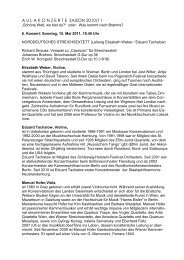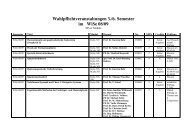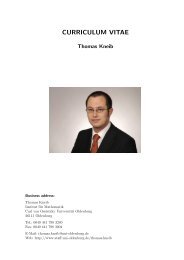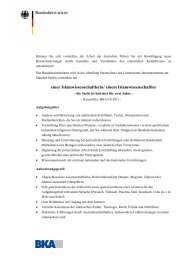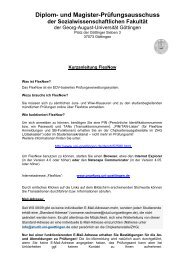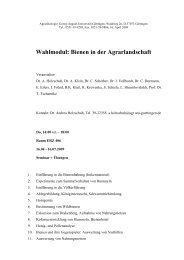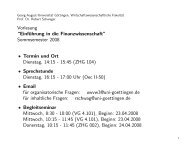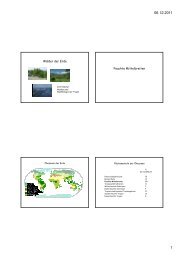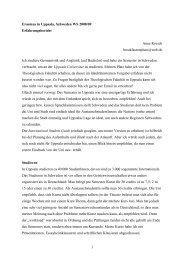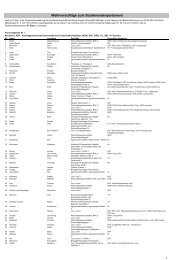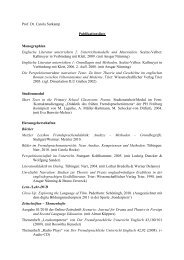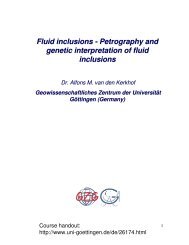The OMC inclusion and national social NGOs: From enthusiasm to ...
The OMC inclusion and national social NGOs: From enthusiasm to ...
The OMC inclusion and national social NGOs: From enthusiasm to ...
You also want an ePaper? Increase the reach of your titles
YUMPU automatically turns print PDFs into web optimized ePapers that Google loves.
With what results, however, remains largely unclear. With respect <strong>to</strong> the ISG, only the officialfrom the Commission <strong>and</strong> the chairman of the ISG mentioned that, again, FEANTSA <strong>to</strong>okpart several times in the sessions whereas EAPN is reported <strong>to</strong> never have asked <strong>to</strong>participate 33 . This participation (<strong>and</strong> the lobbying of FEANTSA) seems <strong>to</strong> have slight impactsas the Commission commissioned a study about the appropriate definition of homelessness<strong>and</strong> related EU-wide indica<strong>to</strong>rs. However, a consensus about indica<strong>to</strong>rs measuringhomelessness has not been found yet. Several <strong>national</strong> delegates stated that there has been noconsultation of <strong>NGOs</strong>, at the <strong>national</strong> level <strong>and</strong> with respect <strong>to</strong> the <strong>OMC</strong> indica<strong>to</strong>rs. Here, themain ac<strong>to</strong>rs (besides the <strong>national</strong> delegates) are officials from Eurostat, OECD or people withan academic background. <strong>The</strong>se findings are confirmed by Friedrich who found that noformal participation rules existed for <strong>NGOs</strong> <strong>and</strong> that a limited degree of access was possibleupon request (Friedrich 2002).As far as the informal way is concerned, both European <strong>NGOs</strong> have produced a number ofpapers, comments about <strong>and</strong> evaluations of this <strong>OMC</strong> 34 <strong>and</strong> evidently try <strong>to</strong> influence theCommission in informal meetings. Camarasa Casals reports that while EAPN criticises thelack of openness of this <strong>OMC</strong>, it still considers that it influences the process. Contrastingly,FEANTSA finds that mobilisation has more resembled information instead of realconsultation <strong>and</strong> that it did not have any impact on the EU agenda (Camarasa Casals 2005).4. ExplanationBefore turning <strong>to</strong> the explanation, let me briefly summarise the results. <strong>NGOs</strong> in both memberstates used the <strong>OMC</strong> <strong>inclusion</strong> in order <strong>to</strong> create structures <strong>to</strong> accompany the process <strong>and</strong>through which awareness raising about the European process could be developed; this wasparticularly remarkable in France where a major effort for gaining synergies was made. Inboth member states, they tried <strong>to</strong> mobilise regional <strong>and</strong> local ac<strong>to</strong>rs beyond those mobilised(or not) by the central administrations, this time more so in Germany, without successhowever. In both cases, consultation by the central administrations was deemed insufficient,even though French <strong>NGOs</strong> perceived an improvement <strong>to</strong> previous years. Little if no learningoccurred through the NAPs which are perceived with great scepticism <strong>and</strong> as governmentalreports aligning measures already in place (see also Br<strong>and</strong>sen et al 2005), the process33 Interview with the secretariat of the ISG, 21.10.2005.34 <strong>The</strong>se can be found at their respective web sites: www.eapn.org <strong>and</strong> www.feantsa.org.



